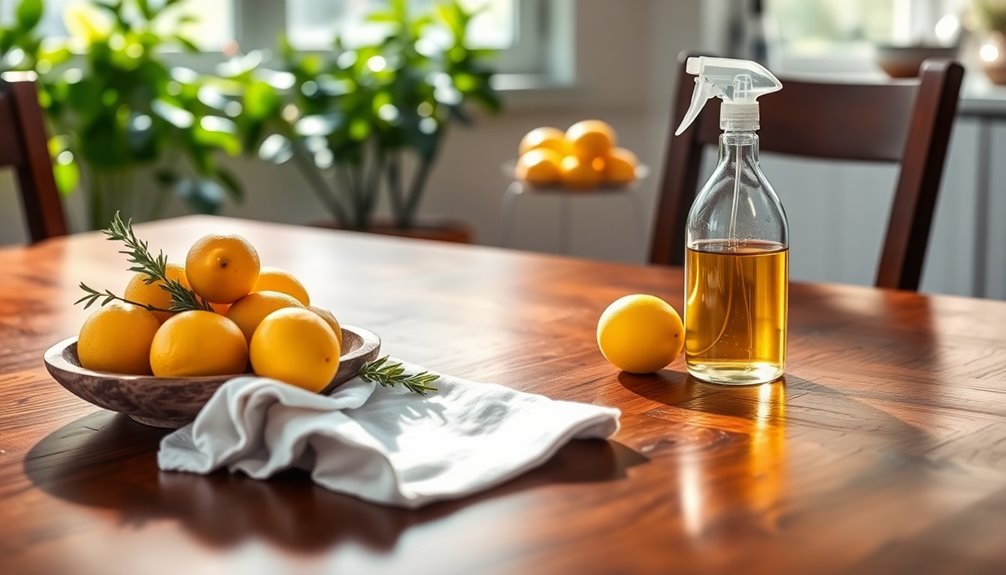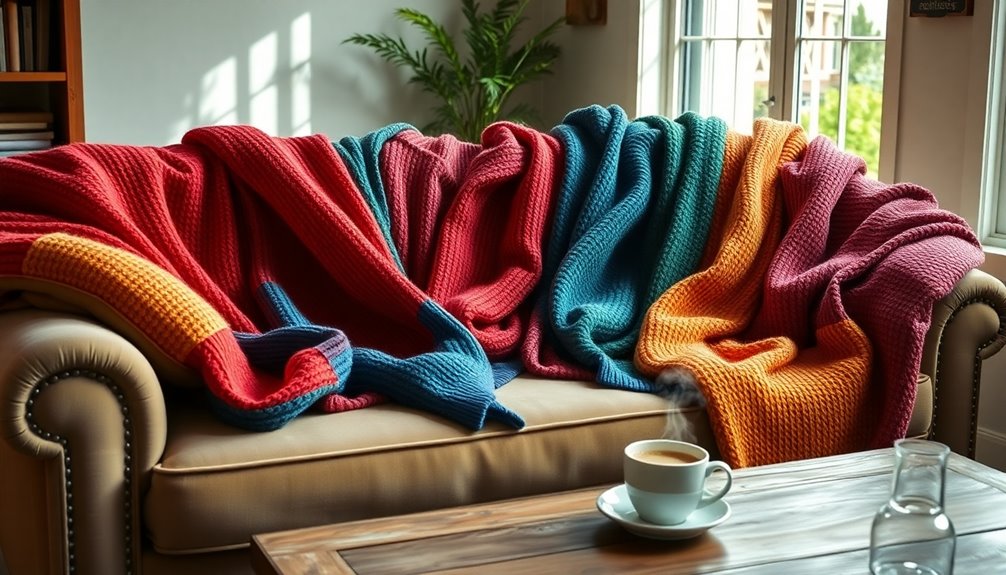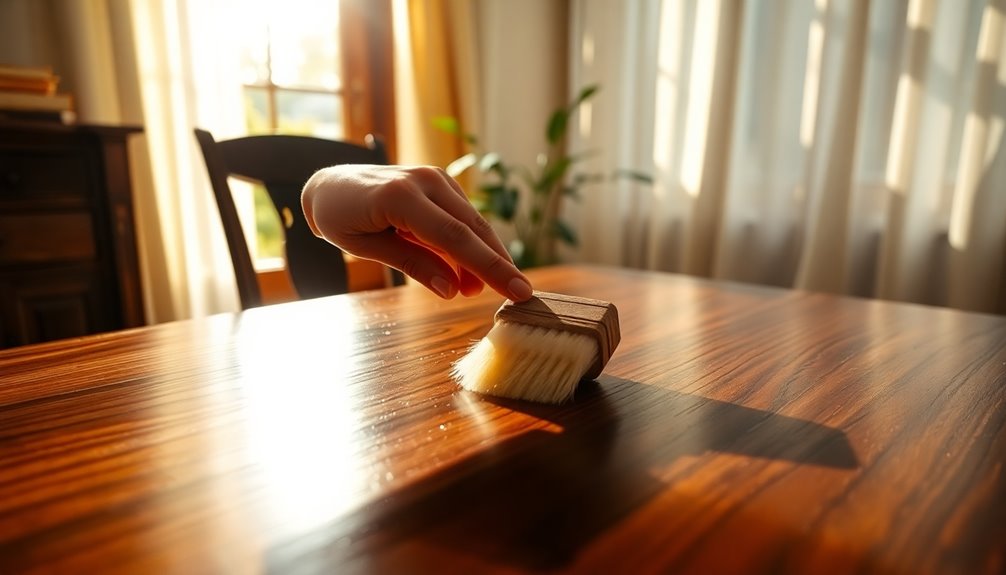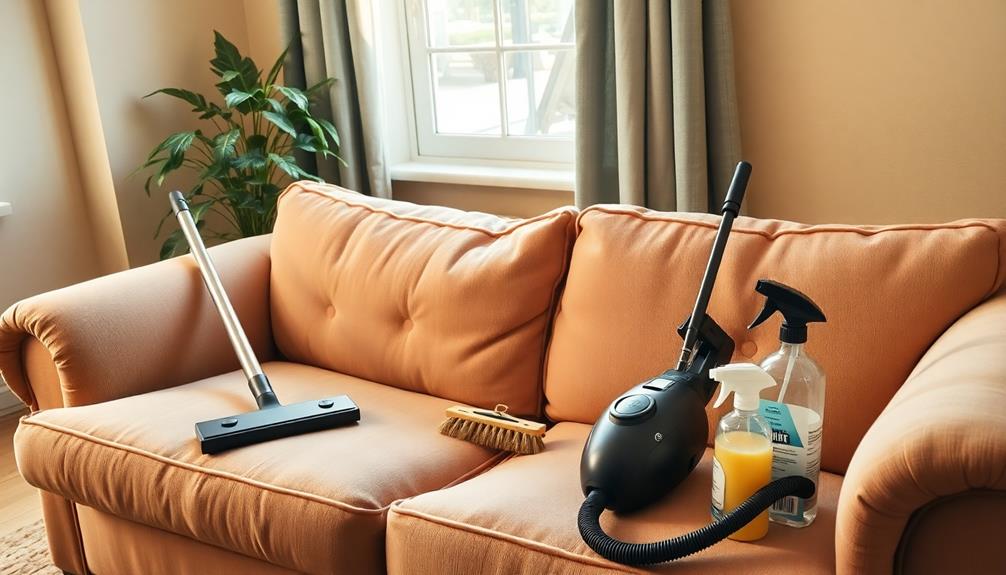To clean your wood furniture naturally, start by dusting it with a soft microfiber cloth, moving from top to bottom. Mix equal parts vinegar and water in a spray bottle for an effective cleaner. Lightly mist the surface and wipe in the direction of the grain using a damp cloth. For stubborn stains, try a baking soda paste or use a bit of mayonnaise for water marks. Don't forget to apply a little olive oil monthly to enhance shine and protect the wood. There's plenty more to discover about keeping your furniture looking its best.
Key Takeaways
- Dust wood furniture regularly with a soft microfiber cloth to remove debris without scratching the surface.
- Create a natural cleaning solution using equal parts vinegar and water, and apply it with a lightly damp cloth.
- For conditioning, mix vinegar and olive oil to enhance shine and protect the wood.
- Address stubborn stains with a baking soda paste or a vinegar solution, gently rubbing and wiping off.
- Use coasters and hot pads to prevent scratches and spills, promoting longevity and maintaining the furniture's appearance.
Understanding Wood Furniture Needs
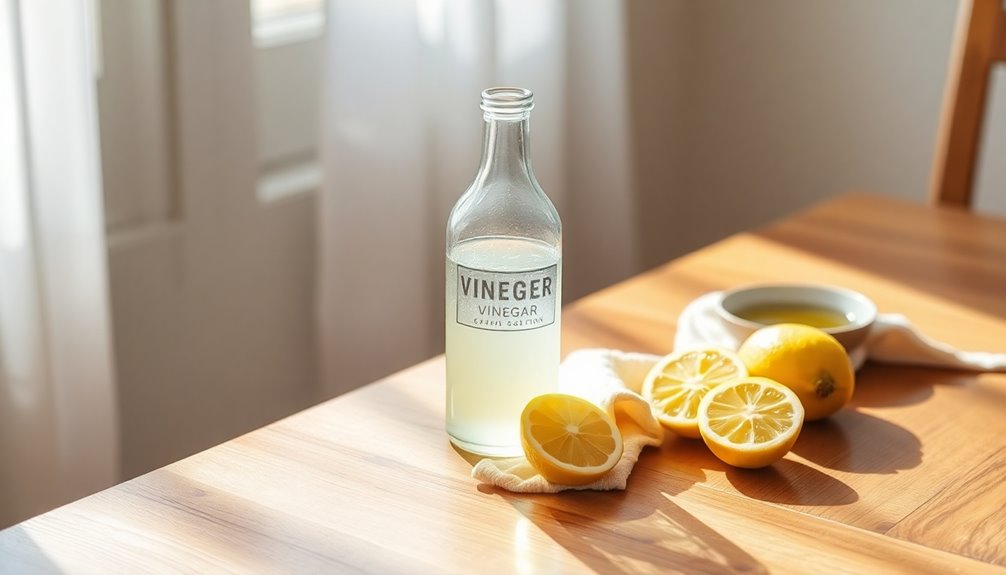
Understanding wood furniture needs is essential for keeping your pieces looking their best. Different types of wood respond uniquely to cleaning methods, so identifying whether you have hardwoods like oak and maple or softwoods such as pine and cedar is crucial. This knowledge helps you choose the right cleaning solutions and techniques to avoid damage. Additionally, wood furniture often features finishes like varnish, lacquer, or oil, which protect and enhance its appearance. Each finish has specific cleaning requirements, so testing with mineral spirits can help determine how to clean it properly.
You should also consider the condition of your furniture. Heavily soiled pieces may need more intensive cleaning than lightly soiled ones, and you must check for cracks or flaking finishes before you start. If the finish is damaged, it's better to hold off on cleaning to prevent further harm. Regular maintenance is important as it enhances the visual appeal of your wood furniture and preserves its integrity over time.
Lastly, remember to avoid harsh chemicals and abrasive cleaners. Opt for natural and mild cleaning solutions like mild dish soap or white vinegar to protect the wood and its finish. Prioritizing these factors ensures your furniture stays beautiful and well-maintained.
Importance of Regular Dusting

Why is regular dusting crucial for your wood furniture? Dusting is essential because it removes layers of dust and debris, keeping your furniture looking clean and inviting. When you dust, you eliminate unwanted particles like dirt, pollen, skin cells, and even insect waste that can accumulate over time. This not only enhances the appearance of your furniture but also prevents dust from scratching the surface, which can cause damage.
Moreover, regular dusting contributes to better air quality in your home. It minimizes the circulation of airborne particles that could affect respiratory health, especially if you or someone in your household suffers from allergies or asthma. By keeping surfaces clean, you also reduce the amount of dust that becomes airborne when disturbed. Additionally, reducing airborne particles through regular dusting can significantly benefit those with respiratory sensitivities.
Finally, consistent dusting helps preserve the wood finish. Dust mixed with moisture can lead to stains, warping, or even mildew growth. By maintaining a dust-free environment, you protect the natural beauty of your wood furniture and extend its lifespan. So, make regular dusting a part of your cleaning routine to keep your wood furniture in top shape!
Natural Cleaning Solutions Overview
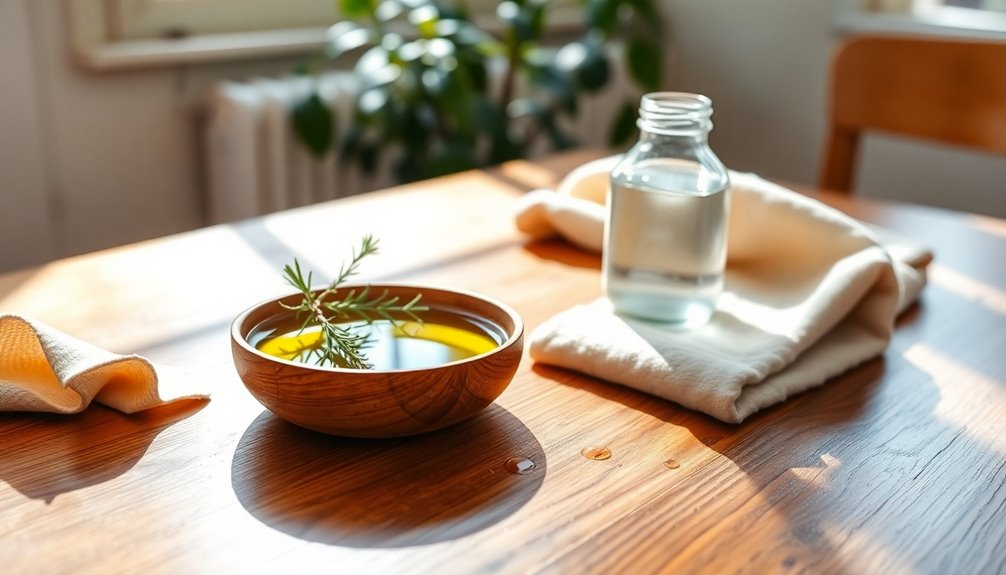
To keep your wood furniture looking its best, using natural cleaning solutions is a smart choice. Not only are these solutions eco-friendly and safe for kids and pets, but they also effectively clean without harsh chemicals. Vinegar serves as a natural disinfectant and deodorizer, perfect for cutting through grime and restoring shine. Combine it with olive oil, a natural conditioner, to hydrate and polish your furniture. Lemon juice can act as a stain remover, adding a refreshing scent to your cleaning routine. Essential oils like lemon, lavender, and tea tree oil enhance your cleaners with pleasant fragrances and antibacterial properties. Regular maintenance practices, including avoiding direct sunlight, are crucial for prolonging the lifespan of your wood furniture.
You can easily create your own cleaners at home. For a versatile cleaner, mix 1 ½ cups of water with ¼ cup of white vinegar, 2 tablespoons of olive oil, and 20 drops of lemon essential oil. For a polishing solution, try 1 tablespoon of white vinegar mixed with 3 tablespoons of olive oil. Remember to test any solution on a small, inconspicuous area first to ensure it's safe for your specific wood finish. By using these natural options, you'll maintain your furniture's health and appearance effectively.
Effective Application Techniques
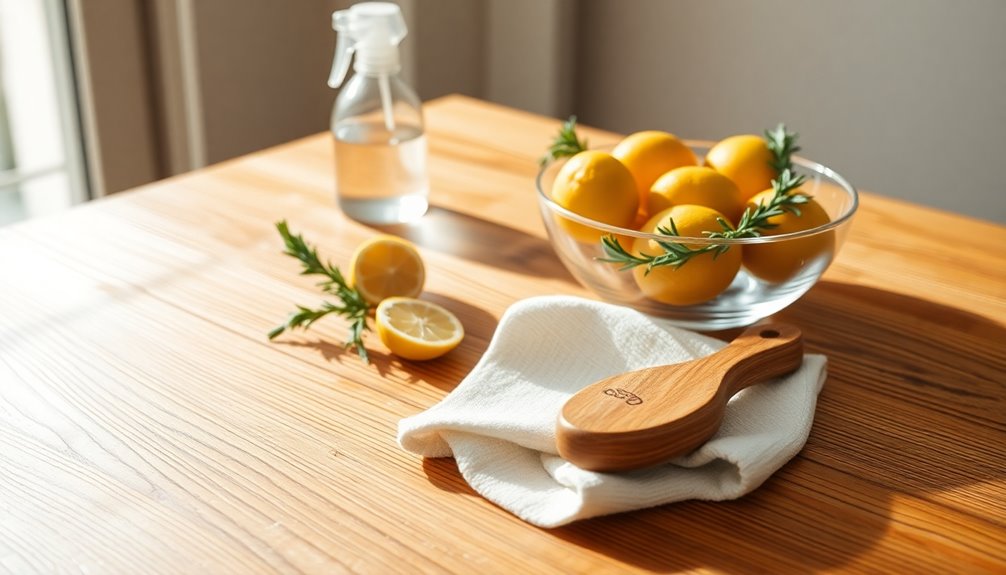
When cleaning wood furniture, using effective application techniques is key to achieving a polished finish without damaging the surface. Start by dusting with a soft microfiber cloth or feather duster. Always begin at the top and work your way down to prevent dust from settling on already cleaned areas. For intricate carvings, a soft-bristle brush or vacuum with a brush attachment works wonders.
Next, prepare your natural cleaning solution, mixing equal parts white vinegar and water in a spray bottle. Shake it well to blend. Dip a soft cloth into the solution, wring it out until it's barely damp, and gently wipe the furniture, always following the wood grain. Avoid using excessive moisture, as this can damage the finish, so it's important to remember that excess water can lead to warping and discoloration of wood.
After wiping, use a clean, dry cloth to immediately remove any remaining moisture and prevent watermarks. Make sure to dry thoroughly, especially in corners where solution might collect. Finally, consider applying a wood polish or oil once a month using circular motions to enhance shine and protect the wood. Always test new solutions on a hidden spot first to ensure safety for your furniture.
Tackling Stubborn Stains
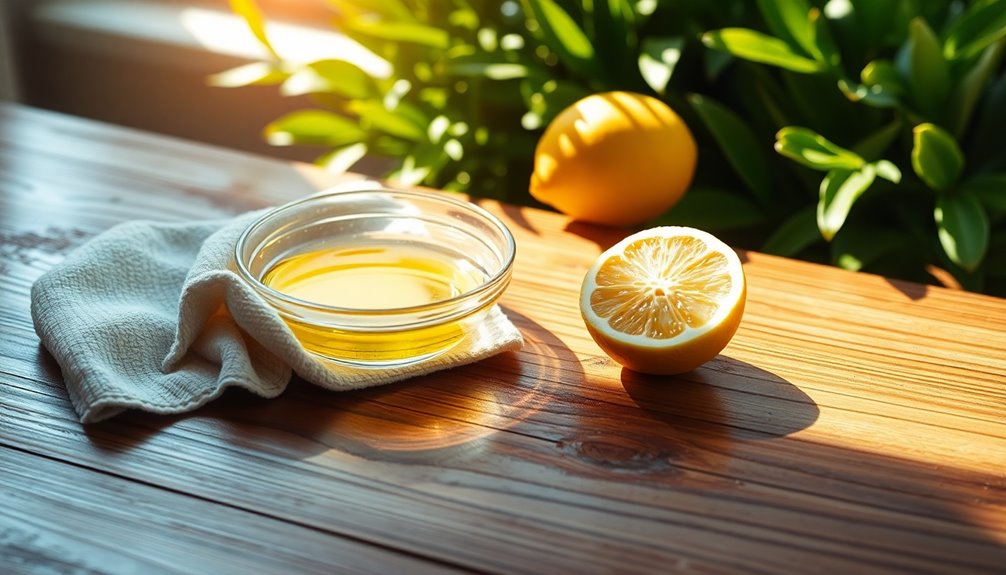
Stubborn stains on wood furniture can be frustrating, but with the right natural solutions, you can restore its beauty. Start with a vinegar solution by mixing equal parts water and white vinegar in a spray bottle. Lightly mist the stained area and wipe it with a soft cloth. This method effectively removes water spots and sticky residue.
For tougher stains, create a baking soda paste by mixing baking soda with water. Apply it to the stain and gently rub with a soft cloth or sponge. Let it sit for a few minutes before wiping off with a damp cloth. If needed, repeat this process.
You can also use mineral oil or a mixture of olive oil and vinegar. Douse a clean rag with mineral oil and scrub the stain, allowing it to penetrate for a while. Alternatively, smear mayonnaise on water stains and let it sit for 3-4 hours. Additionally, if the stain remains stubborn, consider using a stripping gel to effectively remove it before applying natural solutions.
If stains persist, consider lightly sanding the area with fine sandpaper, always sanding in the direction of the grain. This helps prepare the surface for further treatment, ensuring your wood furniture looks its best.
Polishing for Added Shine
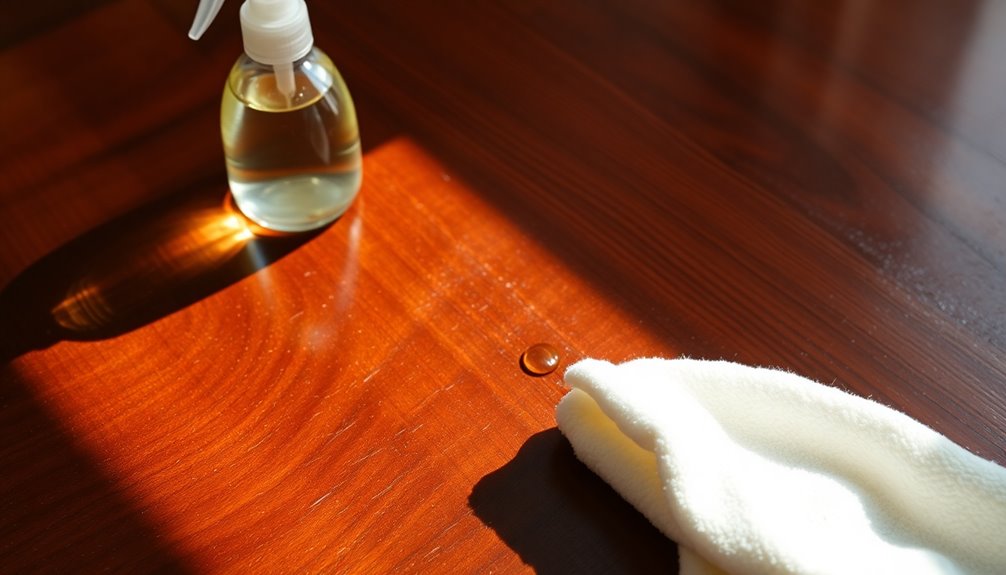
Polishing wood furniture not only enhances its natural beauty but also protects it from wear and tear. To start, choose a wood polish—either commercial or homemade. For commercial polish, apply a small amount to a soft, lint-free cloth. Gently rub the cloth in long, straight strokes, always following the grain. Avoid circular motions to prevent swirl marks.
If you prefer a natural option, mix 1 cup of olive oil, ½ cup of lemon juice, and 1 teaspoon of white vinegar. Alternatively, combine ⅔ cup of beeswax with 3 cups of jojoba oil for a beeswax-based polish. Always test a small area first to ensure the polish won't damage the wood. Regular dusting is essential to start with a clean surface for effective polish adhesion.
When applying, fold your cloth for a firm grip, and use moderate pressure. Buff the surface in small sections, checking for streaks or unevenness along the way. For the final touch, use a separate clean cloth to remove any residue. This not only enhances shine but also keeps moisture at bay. Regular polishing keeps your furniture looking vibrant and helps maintain its longevity.
Maintaining Wood Furniture
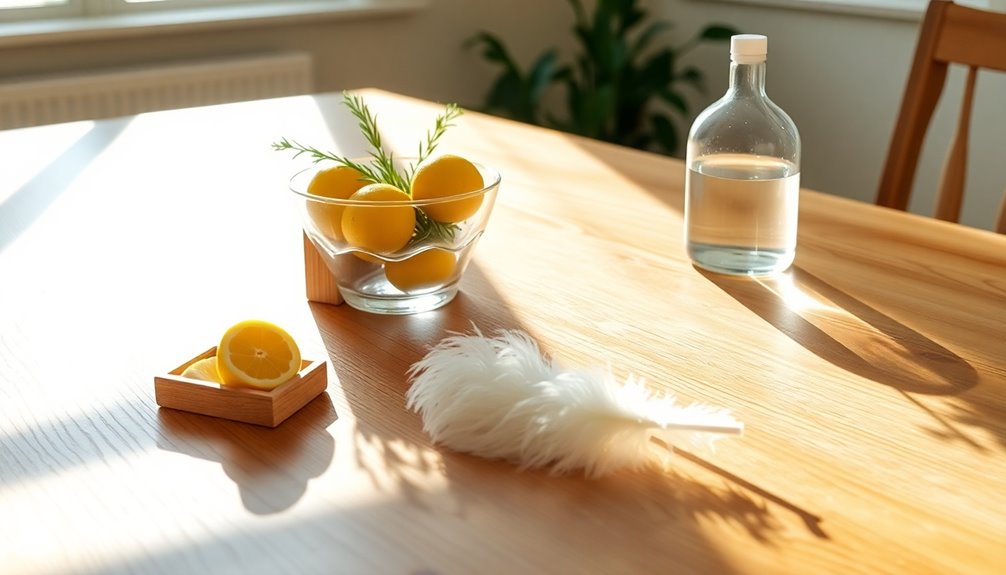
Maintaining wood furniture is essential for preserving its beauty and durability. Start with daily dusting; use a soft microfiber cloth or feather duster to remove dust and debris. Always dust from the top down, ensuring you don't reintroduce dust to cleaned areas. Gently rub in the direction of the wood grain to avoid scratches, and use a soft-bristle brush for intricate carvings and crevices.
For deeper cleaning, prepare natural solutions by mixing equal parts water and white vinegar in a spray bottle. You can also combine 250ml water, 250ml vinegar, and 1 tbsp olive oil for a gentle cleaner. When cleaning, dip a soft cloth into your solution, wring it out until barely damp, and wipe the furniture, always following the wood grain. Regular maintenance is crucial to ensure the longevity of your furniture.
If you encounter stubborn stains, non-gel toothpaste can help with water stains, while a baking soda paste works for heat stains. For ink, use a cotton ball soaked in rubbing alcohol. Always remember to dry the surface immediately with a clean cloth to avoid moisture damage. Regular maintenance makes deep cleaning easier and keeps your furniture looking its best.
Protecting Against Environmental Damage
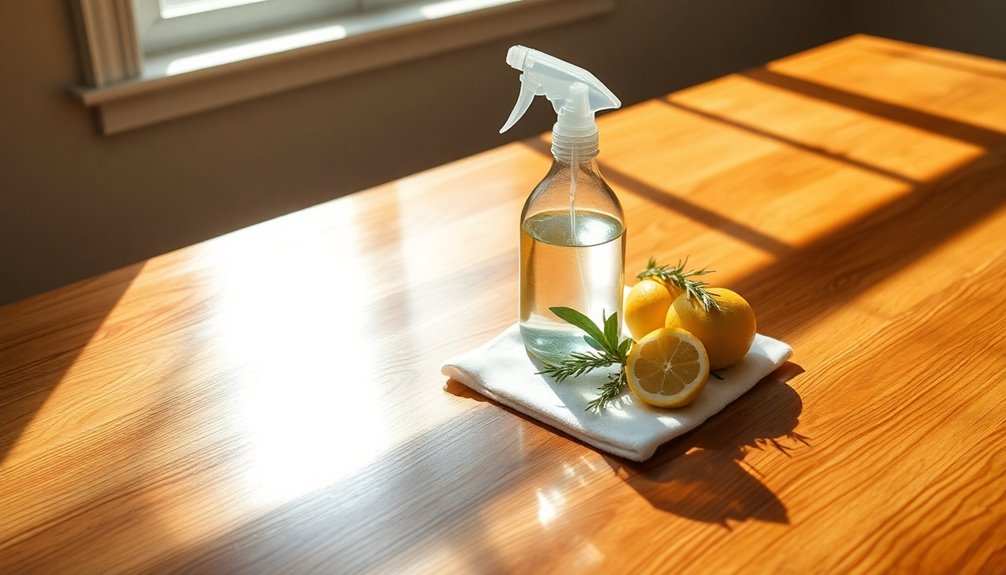
Protecting your wood furniture from environmental damage is crucial to maintaining its integrity and appearance. Start by shielding your outdoor pieces from moisture. Use waterproof covers or tarps to guard against rain and high humidity. Ensure proper drainage around your furniture to prevent water pooling, and always clean and dry your items before covering them to avoid mold and mildew. Secure covers with ties to withstand strong winds.
Next, be mindful of sun and heat exposure. Avoid placing your furniture in direct sunlight or near uncovered windows and vents. Rotate your furniture locations regularly to give them exposure to shaded areas. Consider using UV-resistant covers or protective finishes to prevent fading, and apply paint or sealants to enhance durability. Additionally, choosing naturally resistant woods can significantly enhance your furniture's ability to withstand the elements.
When it comes to wind and extreme weather, use durable, waterproof covers designed for outdoor use. Secure your furniture to prevent it from being moved by strong winds, and bring it indoors during severe weather conditions.
Lastly, maintain structural integrity by applying clear sealants like polyurethane to protect against moisture and UV rays. Regularly inspect your furniture for signs of damage, addressing any issues promptly to ensure longevity.
Choosing Safe Cleaning Products
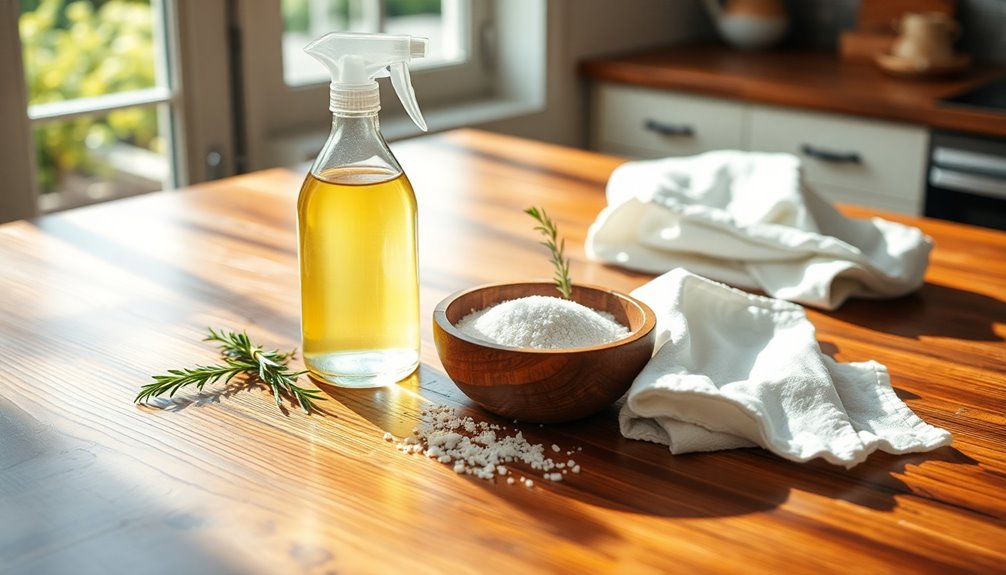
Keeping your wood furniture in great shape goes beyond just protecting it from environmental damage; it also involves using the right cleaning products. When choosing cleaners, look for biodegradable formulations that are water-based or soy-based. These options avoid harsh chemicals, making them safer for both you and your furniture. Ensure the products are free from solvents, caustic substances, and flammable materials.
Opt for non-damaging formulas that work on all types of wood surfaces, whether modern or antique. You want a cleaner that doesn't leave a film or residue and won't dry out or damage the wood. Effective cleaning action is key, so select products that can tackle dust, dirt, grease, and stubborn stains without harshness. Additionally, consider using products that are suitable for daily or deep cleaning to ensure thorough maintenance of your wood surfaces.
Finally, consider user and eco-friendly practices. Look for products recognized by environmental programs like the US EPA's Safer Choice or USDA's BioPreferred Program. These options are safe for greywater and septic systems and eliminate hazmat shipping concerns. Always remember to use masks and gloves when needed, ensuring a safe cleaning experience while caring for your wood furniture.
Tips for Long-lasting Care
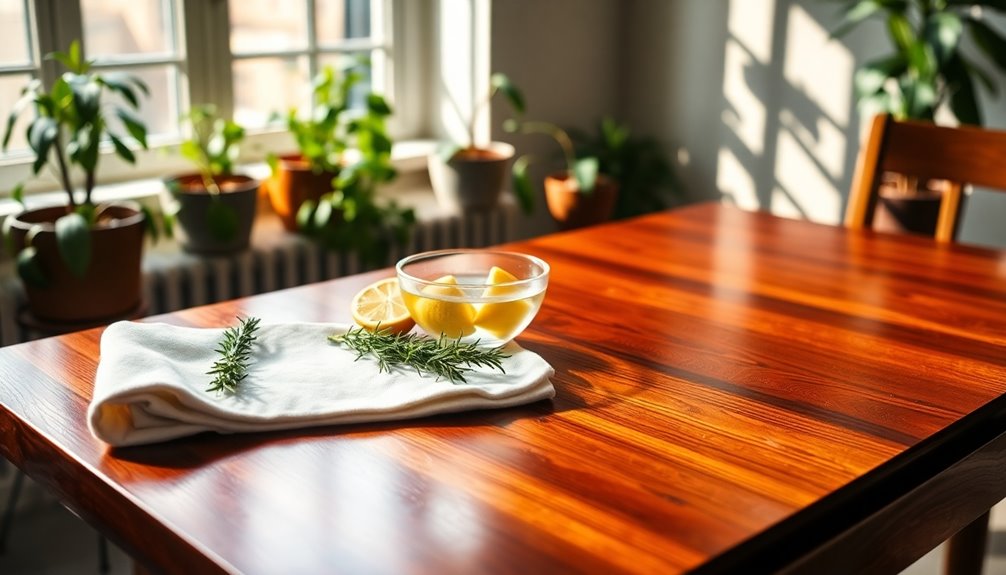
To ensure your wood furniture stands the test of time, it's essential to adopt a few long-lasting care practices. Start by protecting your furniture from environmental factors. Keep it away from heating and cooling vents to prevent warping. Use curtains or blinds to shield it from direct sunlight, which can cause fading. Maintaining a humidity level of 40 to 45 percent is crucial—consider using a humidifier in dry air and a dehumidifier or air conditioner in humid conditions. Consistent humidity control can significantly enhance the longevity of your wood pieces.
Regular cleaning is key, too. Dust your furniture with a soft, lint-free cloth or feather duster to avoid scratches. Wipe it down weekly with a damp microfiber cloth, and clean deeper with a mild dish soap solution. Always dry the wood immediately after cleaning to prevent moisture damage. Additionally, be mindful of the specific type of wood and finish on your furniture, as some may require special care or products. When learning how to clean used furniture effectively, consider using a wood polish to enhance its shine and protect against future scratches. Finally, keep your furniture in a climate-controlled environment to prevent warping or cracking over time.
To protect surfaces, use coasters, hot pads, and placemats to prevent scratches and spills. Tighten loose screws periodically and inspect for signs of wear. Lastly, use a soft-bristle brush for intricate details and avoid harsh cleaners. By implementing these practices, you'll help your wood furniture maintain its beauty and integrity for years to come.
Frequently Asked Questions
Can I Use Furniture Polish Instead of Natural Cleaners?
You can definitely use furniture polish instead of natural cleaners, but it depends on your preference and the wood type. Furniture polish often provides a quick shine and protective layer, making it convenient. However, natural cleaners are eco-friendly and safer for homes with kids and pets. If you choose polish, ensure it's suitable for your specific wood finish to avoid damage. Ultimately, it's about what works best for you and your furniture.
How Often Should I Clean My Wood Furniture?
You should clean your wood furniture regularly to keep it looking its best. Dust it at least once a week, and if it's in a high-traffic area, consider doing it every few days. For deep cleaning, aim for every couple of weeks, especially for frequently used pieces. Remember to inspect for signs of wear and treat any issues promptly to maintain its beauty and integrity over time.
Is It Safe to Use Essential Oils on Wood Furniture?
Yes, it's safe to use essential oils on wood furniture, but you should always take precautions. Dilute the oils with a carrier oil to prevent any damage and conduct a patch test first. Oils like lemon, orange, and cedarwood not only clean but also protect your furniture. Just remember to apply them using a soft cloth, following the wood grain, and avoid soaking the surface to keep it in great condition.
What Should I Do if My Wood Furniture Has Scratches?
If your wood furniture has scratches, you've got some effective options. For minor scratches, try applying vegetable oil or peanut butter; let it sit, then buff it out. For deeper scratches, sand the area smooth and use wood filler. You can also mix white vinegar and olive oil, applying it to the scratch and buffing afterward. Always test any solution on an inconspicuous area first to avoid discoloration.
Can I Use Water to Clean Antique Wood Furniture?
You shouldn't use water to clean antique wood furniture, as it can damage the finish and lead to swelling or buckling. If you do choose to use a damp cloth, make sure it's barely wet. Always test any cleaning solution on an inconspicuous area first to ensure it won't harm the wood. Instead, consider safer alternatives like oil soap or vinegar mixed with water for effective cleaning without the risk.
Conclusion
In conclusion, keeping your wood furniture clean and well-maintained doesn't have to be complicated. By dusting regularly and using natural cleaning solutions, you can preserve its beauty and integrity. Remember to tackle any stubborn stains promptly and protect your pieces from environmental damage. With a few simple tips and safe products, you'll ensure your furniture looks great for years to come. Embrace these practices, and enjoy the timeless elegance of your wood furnishings!
